#Esther Summerson
Text
Esther Summerson over-performs certain aspects of gender (housework; carework; supporting others at the expense of herself) because she knows this is how women are valued in her society; she feels she has to work extra-hard to create value in herself because the emotional abuse she suffered in childhood has made her believe that - as an illegitimate child - she lacks intrinsic value and in fact has negative baseline value compared to other people.
10 notes
·
View notes
Text
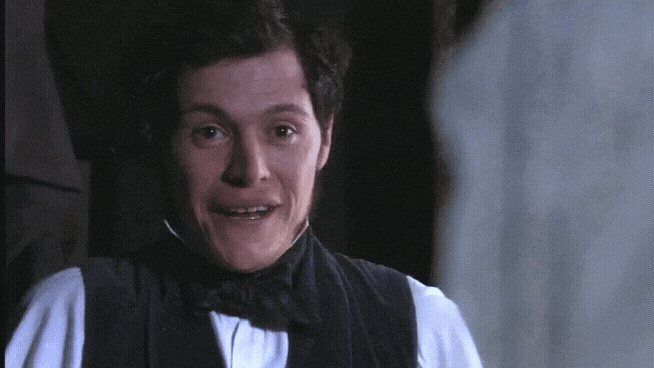

POV: You're trying to have a conversation with the woman you love, but your mother is also in the room.
#there was this one bit where mrs. guppy finally leaves and he rolls his eyes and i wanted to gif it so bad#alas twas a mere second and wouldn't co-operate#burn gorman#bleak house#mr. guppy#mr. guppy if you please#man i need a tag for burn now fuck#my gifs#he's adorable here idc#(l'espirit)#esther summerson#mrs. guppy
11 notes
·
View notes
Text
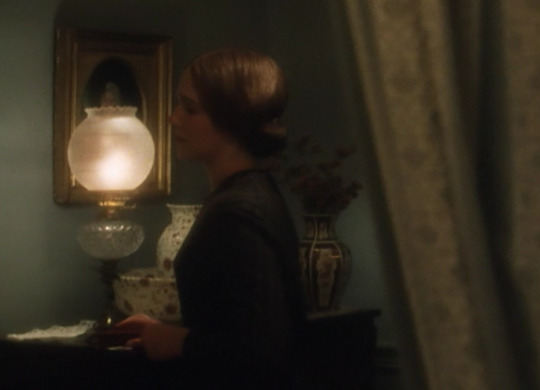
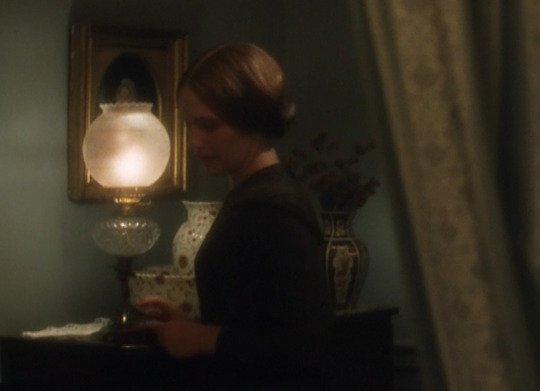
Esther Summerson, Bleak House (1985)
#esther summerson#suzanne burden#bleak house#bleak house 1985#charles dickens#period drama#screen caps#victoriana#victorian aesthetic#masterpiece theater
11 notes
·
View notes
Text
Harold Skimpole: Uh, I think I got your lunch. *Gives Esther note from John that reads "I am very proud of you! Love, John."
Esther Summerson: Oh, yeah. I didn't think this was for me. *Gives Harold a note from John that reads "Be good! For the love of God, please be good!"
10 notes
·
View notes
Text

Bleak House is one of my favourite Dickens novels. It has a bit of everything. Sadness, happiness, love, tradgey and obsession. A wonderful cast of characters from Lady Dedlock to Mr Smallweed. Highly recommend this book!
#Bleak House#Charles Dickens#Lady Dedlock#Esther Summerson#19th century#classic literature#19th century novel#favourite novels#romance#love
5 notes
·
View notes
Text
why are dickens characters so much better than real people though? like Nancy? Louisa? Esther? Pip? Oliver? Davey? Joe Gargery? fuckin Jenny Wren??? would throw hands for any one of them tbh. far superior to any real life celeb.
#books#reading#booklr#charles dickens#my posts#dickensian nonsense#nancy is my baby#louisa gradgrind#esther summerson#pip pirrip#oliver twist#david copperfield#joe gargery#jenny wren#omg and betsey trotwood too!!!#hard times#bleak house#great expectations#our mutual friend#HT#BH#GE#OMF#OT#DC
12 notes
·
View notes
Text
I'm going to a costume ball at the Library of Congress tonight. We're going as our favorite literary characters, so I'll be the weirdo in the hoop skirt and Victorian bonnet.
Oh, and I'm carrying a giant key ring.
...
Hope the librarians don't make me go through a metal detector 😬
1 note
·
View note
Text
{ Jenny and I are both obsessed with the fact that the Los Angles Public Library’s collection was started with money raised from a week-long “Dickens Party” that was held in 1872 where all the partygoers were encouraged to dress as their favorite Dickens characters }
#I just needed you all to know this#library science school has been illuminating in weird ways thus far#Jenny called Esther Summerson from Bleak House in case anyone was wondering#this is tied closely with Amy Dorrit from Little Dorrit#and Biddy from Great Expectations#I had trouble picking a favorite dickens lady#and unfortunately my personal knowledge of dickens is largely restricted to Wikipedia and the muppets Christmas Carol#ooc
0 notes
Text
It has come to my attention that it's Period Drama Appreciation Week 2023.
I love period dramas and grew up watching them. They have been a formative part of my life and I'm now too disabled to watch video. Even gifs are too difficult for my brain to process.
It is also Bi Visibility Week and I'm posting this on Bisexual Visibility Day.
Since I can't safely post a pile of gifs, here is a list celebrating actors/characters/moments from period dramas that have been significant to my bisexuality.
[Yes, this is a big list. I am missing out on watching and re-watching A Lot of awesome period dramas and I hate it. This list is helping me reclaim a bit of joy. Also I've probably forgotten some favourites and may update this.]
Lori Petty in A League of Their Own
Jodhi May in any period drama
Mary Wickes in any period drama
Freddy Honeychurch in A Room with a View
Anne Hathaway playing cricket in that rust-coloured dress in Becoming Jane
Esther Summerson (disabled heroine!) & Allan Woodcourt in Bleak House
the freshly-painted yellow cabin door swinging shut with the names 'Calam & Katie' painted on it in Calamity Jane
the sequence where Doris Day sings 'Secret Love' in Calamity Jane
Michelle in Derry Girls (and James too, a wee bit)
George Eliot & Lenore in Edgar Allan Poe's Murder Mystery Dinner Party
the moment where Emma and Mr Knightley start dancing together and it feels like you're inside the music in Emma
Polly Waker's haircut in The Enchanted April
Matthias Schoenaerts in Far From the Madding Crowd
Idgie & Ruth in Fried Green Tomatoes
Suranne Jones in Gentleman Jack
recognising Marian Lister as a bisexual who hasn't realised it yet in Gentleman Jack
Mary Agnes McNue in Godless
Bel & Freddie in The Hour
June Allyson leaping over a hedge (or is it a fence?) as Jo March in Little Women
the Patricia Rozema adaptation of Mansfield Park
the whole sequence where Judy Garland strides onto the neighbours' porch to sock The Boy Next Door in the jaw in Meet Me in St Louis
Katie the cook in Meet Me in St Louis
the moment where Benedick braces his arm against a doorframe in a desperate panic to stop Beatrice from going to eat Claudio's heart in the marketplace in Much Ado About Nothing
Denzel Washington in Much Ado About Nothing
Mr Thornton's hands (ok, and also his face) in North & South
tomboy Doris Day in On Moonlight Bay
Valentine in Parade's End
all of Portrait of a Lady on Fire
Papi in Pose
Lizzy Bennet declaring that she would never marry someone she did not love in Pride & Prejudice
Mr Darcy diving into a pond in Pride & Prejudice
both Angel and Joanne in Rent (the 2008 broadway version)
Martha the maid in The Secret Garden
Lelia Walker in Self-Made
swashbuckling Margaret Dashwood in Sense & Sensibility
the dance sequences in Seven Brides for Seven Brothers
the whole Thomas Kent situation in Shakespeare in Love
Maria (when she is not a nun) in The Sound of Music
Kitty Butler onstage in Tipping the Velvet
Annie and Janette and Jacques and Linh in Treme
Audra McDonald and Anne Hathaway and Raúl Esparza in that promotional photo for Twelfth Night
Julie Andrews and her male co-star singing a version of 'Home on the Range' with the line 'and the deer and the antelope are gay' in Victor/Victoria
Justine Waddell in Wives & Daughters
40 notes
·
View notes
Note
Which Bleak House miniseries is your go-to? I have yet to see a good adaptation of it and it's a favourite book of mine. Did you know that my Nook eReader is named Esther Summerson?
I really like the 2005 one! I had a lot of fun watching it. I will admit, I have not yet read the book though. Also lmfaoooo re: Ester.
6 notes
·
View notes
Text
"BLEAK HOUSE" (1985) Review
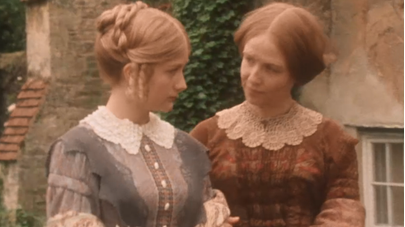
"BLEAK HOUSE" (1985) Review
In less than I year, I have developed this fascination with the works of Charles Dickens. How did this come about? I do not know. I have seen previous Dickens movie and television adaptations in the past. But ever since last year, I have been viewing these adaptations with a vengeance. And one of them turned out to be "BLEAK HOUSE", the 1985 adaptation of Dickens' 1852-53 novel.
Adapted by Arthur Hopcraft, this eight-episode miniseries conveyed the affects of Jarndyce v Jardyce, a long-running legal probate case involving the existence of more than one will. The heirs and their descendants have been waiting decades for the court to determine the legal will, for the sake of a large inheritance. Among those affected by the Jarndyce v Jardyce case are:
*John Jarndyce - a wealthy English landowner, who happens to be the proprietor of the estate, Bleak House. Jarndyce had inherited it from his uncle Tom Jarndyce, who had went mad waiting for a verdict on the case before committing suicide.
*Richard Carstones - Tom Jarndyce's grandson and John Jarndyce's cousin, who also became one of the latter's legal wards, and a potential beneficiary of the Jarndyce v Jardyce case.
*Ada Clare - Tom Jarndyce's granddaughter and Mr. Jarndyce's cousin, who also became one of his legal wards, and a potential beneficiary of the Jarndyce v Jardyce case. She and Richard, also cousins, became romantically involved.
*Esther Summerson - one of the novel's main characters and orphan, who became Mr. Jarndyce's ward following the death of her previous guardian, Miss Barbury, who had also been her biological aunt. She joined the Bleak House household as Ada's companion and Mr. Jarndyce's housekeeper after he became the guardian of Richard and Ada.
*Honoria, Lady Dedlock - the wife of baronet Sir Leicester Dedlock and a beneficiary of the Jarndyce v Jardyce case. She is also the younger sister of Miss Barbury and Esther's illegitimate mother.
*Captain John Hawdon aka Nemo - a former British Army officer, who became an impoverished law writer and drug addict. He is also Lady Dedlock's former lover and Esther's illegitimate father. His penmanship on one of the Jarndyce v Jardyce affidavit attracts Lady Dedlock's attention.
*Mr. Bill Tulkinghorn - Sir Leicester's ruthless lawyer, who noticed Lady Dedlock's reaction to the affidavit. This leads him to investigate her past and possible connection to Hawdon aka "Nemo".
*Miss Flite - An elderly woman living in London, whose family had been destroyed by a long-running Chancery case similar to Jarndyce v Jarndyce. This has led her to develop an obsessive fascination with Chancery cases, especially the main one featured in this story. She quickly befriended Esther, Richard, Ada and Mr. Jarndyce.
As one can see, these characters represented plot arcs that connect to the Jarndyce v Jarndyce case. As one of the beneficiaries of the Jarndyce case, Richard becomes obsessed with the verdict. He seemed more interested in depending upon the Jarndyce verdict to provide him with an income rather than pursue a profession. This obsession eventually led to a clash between and Mr. Jarndyce, who has tried to warn him not to get involved with the case. Another clash formed between Lady Dedlock and Mr. Tulkinghorn, due to his determination to find proof of her past with Nemo and the conception of their child. A clash that proved to create even more damaging for a good number of people, than the one between Mr. Jarndyce and Richard. In the midst of all this stood Esther, who served as an emotional blanket for several characters - especially the inhabitants at Bleak House, a potential romantic figure for three men (ironic for a woman who was not supposed to be a great beauty), and the center of the Lady Dedlock-Nemo scandal.
For years, 1985's "BLEAK HOUSE" had been viewed as the superior adaptation of Dickens' novel. The first novel aired back in 1959. But a third television adaptation that aired in 2005 had managed to overshadow this second adaptation's reputation. But this is not about comparing the three adaptations. I am focusing only the 1985 miniseries. If I might be blunt, I believe screenwriter Arthur Hopcraft and director Ross Devenish created one of the better Charles Dickens I have personally seen. Granted, one might use the source material - the 1952-53 novel - as the reason behind the miniseries' top quality. But I have seen my share of poor adaptations of excellent source material . . . and excellent adaptations of poor or mediocre novels and plays. And I would find this excuse too simply to swallow. Hopcraft and Devenish could have easily created a poor or mediocre adaptation of the novel. Fortunately, I believe they had managed to avoid the latter.
With eight episodes, Hopcraft and Devenish did an excellent job in conveying Dickens' exploration into the chaos of the legal landscape in 19th century Britain, especially cases involving the Chancery courts. One might consider the longevity of Jarndyce v Jarndyce rather exaggerated. However, I speak from personal experience that an extended length of time in such a case is more than possible. But what I thought the effect of Jarndyce v Jarndyce and similar cases in Dickens' story seemed very interesting. In Richard Carstone's case, I suspect his own hubris and upbringing had allowed the case to have such a toxic effect upon him. He had been raised as a gentleman. Which meant he was not expected to work for a living. But since he did not possess a fortune or an estate - like Mr. Jarndyce - Richard never lost hope that the court would rule the Jarndyce v Jarndyce case in his favor, allowing him to inherit a great deal of money. Although it took another case to send Miss Flyte mentally around the bend, I found it interesting that her obsession with Chancery cases led her to attach her interest to the Jarndyce case beneficiaries.
The Jarndyce case also produce a group of leeches in the forms of attorneys like Mr. Tulkinghorn and his obsession with assuming control over the Dedlocks and Mr. Vholes, who had sucked a great deal of money from Richard in exchange for his legal services. The series also featured the vicious moneylender Mr. Smallweed, who helped Mr. Tulkinghorn in the latter's campaign against Lady Dedlock; and Mr. Jarndyce's "friend", Harold Skimpole, who had not only encouraged Richard to pursue a greater interest in the Jarndyce case, but also had accepted a "commission" from Vholes to recruit the young man as a client. Would I regard William Guppy as a leech? Sometimes. I had noticed that one particular story arc was missing - namely the story arc regarding the philanthropist Mrs. Jellyby, her daughter and Esther's friend, Caddy and the Turveydrop family. This did not bother me, for I have never been a fan of that particular arc.
However, I also noticed that "BLEAK HOUSE" featured a few moments in which important plot points had been revealed through dialogue or shown after the fact. Audiences never saw Skimpole convince Richard to hire Mr. Vholes. Instead, Mr. Jarndyce had revealed this incident after it happened. The whole scenario regarding Dr. Allan Woodcock being a survivor of a shipwreck was handled as a past event revealed by the good doctor himself. Hopcraft's script never stretched it out in the same manner as Dickens' novel or the 2005 miniseries. Audiences never saw George Rouncewell's release from jail, for which he had been incarcerated for murder. Instead, Episode Seven began with George in jail and later, near the end, found him serving as Sir Leicester's valet without any information on how that came about.
"BLEAK HOUSE" featured a few other writing and direction decisions by Hopcraft and Devenish that I found . . . well, questionable. Why did the pair solely focused on Lady Dedlock in the series' penultimate episode and Richard and the Jarndyce v Jarndyce case in the final one? Would it have been so difficult for them to switch back and forth between the two arcs in those final episodes? I found Inspector Bucket's resolution to the story's murder mystery rather rushed. I would have liked to see Bucket eliminate suspects before solving the case. In Bucket's final scene with the killer, Hopcraft left out that moment from the novel when the latter had the last scathing word on British society, leaving the police detective speechless. This erasure dimmed the impact of Dickens' message and made the killer even more of a caricature. I had some issues with how Devenish directed certain performances. How can I put this? I found them a bit theatrical.
I have one last issue - namely Kenneth MacMillan's cinematography. I realize that in "BLEAK HOUSE", fog represented institutional oppression and human confusion and misery in society. Unfortunately, I feel that MacMillan may have been heavy-handed in utilizing this symbol in the series. It is bad enough that photography featured a fuzzy element that seemed popular in many period productions in the 1970s. But thanks to MacMillan's use of fog in the story, there were many moment in which I could barely see a damn thing. And I found that irritating.
Aside from a few quibbles, I had no real issues with the performances featured in "BLEAK HOUSE". One of those quibbles proved to be the performances for some of the secondary cast members. How can I say this? The exaggerated and wooden performances for some of the cast members brought back memories of some of the minor actors' bad performances in 1982 miniseries, "THE BLUE AND THE GRAY". I must admit that I did not care for Pamela Merrick's portrayal of Lady Dedlock's French maid, Madame Hortense. Her performance bordered and then surpassed the lines of caricature - as some British actors/actresses tend to do. Charlie Drake's portrayal of the moneylender Smallweed tend to waver between a pretty solid performance and pure caricature. Although there were moments when I found her portrayal of the eccentric Miss Flyte a bit hammy, I must admit that Sylvia Coleridge gave a well-done performance. Chris Pitt's performance as Jo, the crossing sweeper boy struck me as very poignant. Yet, at the same time, he seemed so passive that at times, I found it difficult to believe he had survived on the streets on his own, for so long. Jonathan Moore, whom I had remembered from the 1988 television movie, "JACK THE RIPPER"; did an excellent job of conveying the ambitious and self-interested nature of law clerk William Guppy. However, his portrayal of Guppy seemed to lack the character's comedic nature. Denholm Elliot gave a very interesting performance as Esther, Richard and Ada's guardian, John Jarndyce. On one level, I found his portrayal of the kind-hearted Mr. Jarndyce as first-rate. Excellent. But there were moments, including the character's famous quote following Jo's death, when Elliott's Mr. Jarndyce seemed to resemble one of those "angry young men" characters from a John Osbourne play. I found those moments very odd.
However, there were performances that did not leave me scratching my head. Colin Jeavons and Anne Reid gave very competent performances as the grasping solicitor Mr. Vholes and George Rouncewell's close friend Mrs. Bagnet, respectively. Ironically, Jeavons had portrayed Richard Carstone in the 1959 adaptation of "Bleak House" and Reid had portrayed Mrs. Rouncewell in the 2005 television adaptation. Both Suzanne Burden and Lucy Hornak gave solid performances as Esther Summerson and Ada Clare. And yet, both actresses managed to rise to the occasion with some brilliant moments. Burden's moment came, following Esther's realization that she had survived the smallpox. As for Hornak, she gave an excellent performance during Ada's soliloquy about her love's growing obsession with the Jarndyce case. Brian Deacon gave a passionate performance as Dr. Allan Woodcourt, the penniless doctor in love with Esther. Ian Hogg gave a very solid, yet commanding performance as Inspector Bucket. I really enjoyed Sam Kelly's warm portrayal of the law-stationer, Mr. Snagsby. Bernard Hepton gave one of the most colorful performances of his career as the alcoholic rag and bone shopkeeper, Krook. Dave King gave a very solid performance as the loyal, yet intimidating and conservative former Army sergeant George Rouncewell. I found George Sewell's performance as Sergeant Rouncewell's older brother, the wealthy Mr. Rouncewell not only entertaining, but very memorable. I thought Robin Bailey did an excellent job portrayed the haughty and proud Sir Leicester Dedlock.
But there were four performances that really impressed me. One came from Philip Franks, who did an excellent job of conveying Richard Carstone's emotional journey from John Jarndyce's warm and friendly young man, to the more embittered one, obsessed with the Jarndyce case. T.P. McKenna gave a delicious performance as Mr. Jarndyce's self-involved friend, Harold Skimpole, who proved to be quite the emotional (and financial) vampire. I thought Peter Vaughan was superb as the Dedlocks' sinister lawyer, Mr. Tulkinghorn. I was amazed by how Vaughn managed to combine the character's dedication to protecting his client Sir Leicester and his penchant for assuming control over others. If I had voted for the best performance featured in "BLEAK HOUSE", I would choose Diana Rigg's portrayal of the tragic Honoria, Lady Dedlock. I believe the actress gave a brilliant performance as the mysterious, yet complicated baronet's wife, whose cool demeanor hid a great deal of emotions and a personal secret. I am shocked and amazed that neither she, Vaughn, McKenna or Franks had ever received any accolades for their performances.
In fact, I am surprised that "BLEAK HOUSE" had only received BAFTA nominations (and won three) . . . and they were in the technical/arts category, aside for the Best Drama Series/Serial. No Primetime Emmy nominations, whatsoever. Was this eight-part miniseries the best adaptation of Charles Dickens' 1852-53 novel? I cannot answer that question. Granted, it had its flaws. But what television or movie production did not? But I cannot deny that "BLEAK HOUSE" was a first-rate miniseries that deserved more accolades than it had received, thanks to Arthur Hopcraft's screenplay, Ross Devenish's direction and an excellent cast led by Suzanne Burden, Denholm Elliott and Diana Rigg.
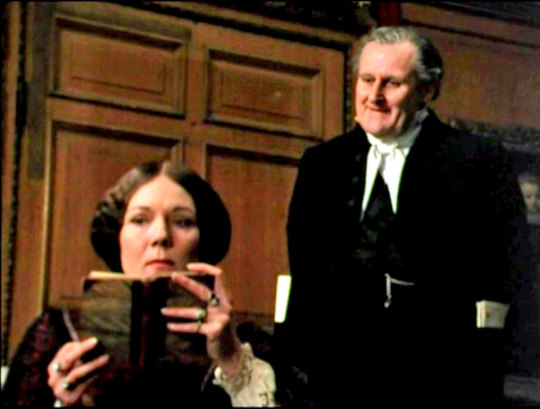
#charles dickens#bleak house#bleak house 1985#arthur hopcraft#ross devenish#suzanne burden#denholm elliott#diana rigg#peter vaughan#philip franks#lucy hornak#colin jeavons#anne reid#dave king#george sewell#robin bailey#brian deacon#chris pitt#sam kelly#ian hogg#jarndyce v. jarndyce#jonathan moore#pamela merrick#sylvia coleridge#charlie drake#bernard hepton#t.p. mckenna#victorian age#period drama#period dramas
4 notes
·
View notes
Text
Been thinking lately about David Copperfield and Esther Summerson…
Similarities:
Affectionate;
Trusting;
Hard workers;
Seek the approval of others and to please others;
Heavily relied-upon by other characters for practical and emotional support;
Have a deep sense of gratitude to the people who have benefitted them, and try their best to ‘repay’ them in some way;
Place a high value on the domestic;
Have a plethora of nicknames (relates to their quests for identity and belonging);
Bisexual Have at least one opposite-sex romantic interest and at least one same-sex intimate friendship;
Differences:
They approach some of the above in differently-gendered ways;
How deeply they interrogate their own psychology and/or how open they are about what they find there: David usually interrogates his own past thoughts and feelings deeply, and will be pretty honest about whatever conclusions he comes to even when he’s ashamed about it (it’s possibly worth noting that part of the subtitle that appeared on the wrapper for the serial editions of David Copperfield was ‘(Which He never meant to be Published on any Account)’, meaning he didn’t really write it for public consumption); Esther, on the other hand, while she does often begin the same process of digging into her past thoughts and feelings, will often shy away from the conclusions, usually on the basis of ‘well it’s about me, so it doesn’t really matter’;
Naivety and idealism: David is more idealistic and naive than Esther, who is more able to see things as they are (not just compared to David, but also compared to others in her social circle; she is able to see past the façade of characters like Mrs Jellyby and Harold Skimpole more than John Jarndyce, past the façade of Mr Turveydrop than Caddy, more able to recognise the changes in Richard than Ada, etc) - however, Esther also trusts her own perception of reality less than David does, and David becomes less naive and idealistic as he gets older (especially from the age of about 21 onwards), so this is probably reversed by the end of the novels. David is now less naive and more of a realist than before, and Esther - while preserving a good instinct for the reality of things - still struggles to trust her own perceptions, past or present, and right to the end of the book shies away from concluding her thoughts and pinning down her truths
- even supposing -
The differences, I think, mainly come down to a difference in self-esteem: Esther does not recognise or cannot acknowledge her own worth; David can and does.
This difference in self-esteem stems from their childhood: Esther was emotionally abused for the first fourteen years of her life
“It would have been far better, little Esther, that you had had no birthday, that you had never been born!”
and her only friend until that age was her doll; David, on the other hand, experiences more varied forms of abuse (emotional abuse, physical abuse, neglect, deprivation of education, child labour, completely unnecessary food-insecurity and shelter-insecurity, etc) but they are for shorter periods of time; David’s earliest memories are happy, and by the comparable age of fourteen he has regained a secure domestic situation and has multiple people he loves and who love him. Perhaps most important of all to his self-esteem is the fact that - even during the darkest, most unsettled time of his childhood - he always, always had at least one person who he knew loved and valued and believed in him: Peggotty
I broke down as I was trying to say [to aunt Betsey] that her home [Peggotty’s] was my home, and that all she had was mine, and that I would have gone to her for shelter, but for her humble station, which made me fear that I might bring some trouble on her
So yeah, David and Esther are similar in many ways, and both strive for the same things, but they are coming at it from slightly different angles. Esther desires the emotional security, domestic happiness, and love she never had in childhood; David is trying to regain the same.
#this written after seeing one too many comments hating on esther for either symptoms of abuse or the same charactertistics DC has...#to be fair maybe they also don't like david#but i think often people hold characters who are women to different standards to those who are men...#and they don't always realise they're doing it#sorry about the grammar in this post by the way it got away from me a bit#esther summerson#david copperfield#clara peggotty#(mvp)#bleak house#david copperfield (book)
4 notes
·
View notes
Text
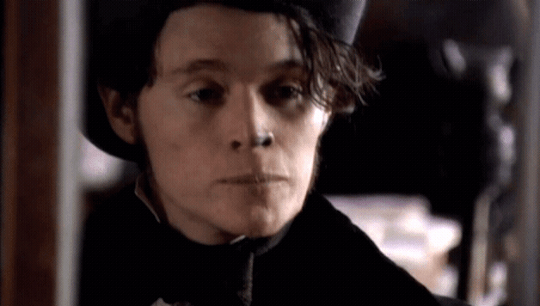



"Oh no..."
Upon discovering an ink stain upon his nose, Mr. Guppy frantically tries to remove it.
Bonus Esther:
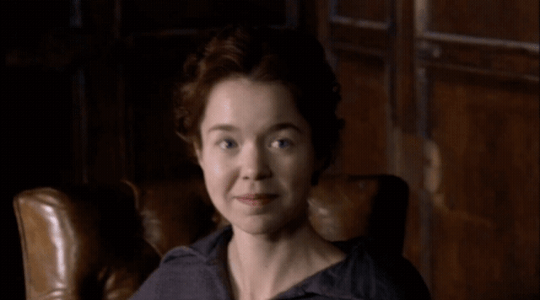
#burn gorman#anna maxwell martin#bleak house#mr. guppy#william guppy#esther summerson#girl same ^_^;#mr. guppy if you please#man i need a tag for burn now fuck#her smile was too cute to NOT make into a gif#god i have been in his shoes way too many times#trying to impress a cute girl. mortified when you realise something was amiss the whole bloody time.#bleak house 2005#my gifs
17 notes
·
View notes
Text




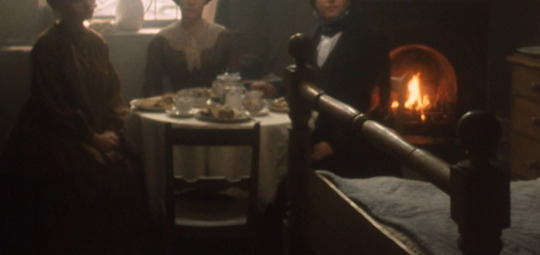
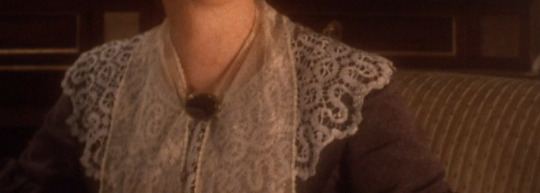

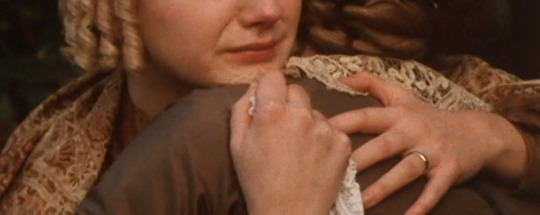
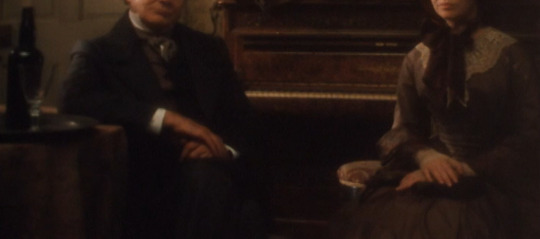
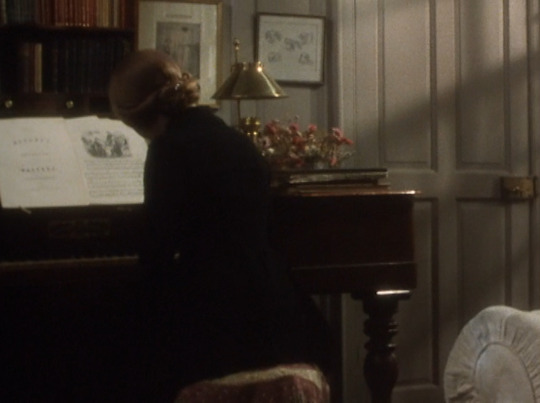

Bleak House (1985), episode 8
Dir. Ross Devenish. Suzanne Burden as Esther Summerson, Denholm Eliot as John Jarndyce, Lucy Hornak as Ada Clare, Phillip Franks as Richard Carstone, T. P. McKenna as Harold Skimpole, Brian Deacon as Alan Woodcourt, Syliva Coleridge as Miss Flite
#bleak house#bleak house 1985#charles dickens#period drama#period film#period piece#classic lit#classic lit aesthetic#classic literature#classic literature adaptation#film adaptation#classic literature aesthetic#victoriana#victorian aesthetic#dark academia#victorian academia#dark academia aesthetic
18 notes
·
View notes
Text
Ada Clare, holding a baby bunny and baby pig that are trying to get away from her: A little stray baby pig.
Esther Summerson: Technically, I don't think there are any stray animals on a farm, Ada.
Ada Clare: This pig, this bunny and I are like a family that's trying desperately to get away from each other at any cost. Like a family.
4 notes
·
View notes
Text

0 notes